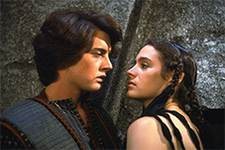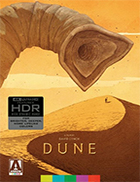Dune (1984) (4K UHD)
|  David Stratton interviewing David Lynch at the Gallery of Modern Art in Brisbane, Australia, in March 2015: Strattton: “David … do you want to say anything about Dune?” Lynch: “Not a lot.” [Audience laughter.] The audience laughs at this exchange because they know: David Lynch doesn’t talk about Dune much. At the time of the film’s theatrical release in December 1984, he gave the required interviews, and over the years he has spoken about it here and there, but he has otherwise remained largely silent on his third feature film, which was released with great fanfare and high hopes, but ended up tanking at the box office. Box office numbers, of course, have nothing to do with Lynch’s silence on the film and his refusal to participate in any of its various home video releases or attempts to recut it. Rather, his distance from the project relates to the fact that he never had complete creative control over it, did not have final cut, and had to compromise much of his vision due to both financial exigencies and the pressure to produce something “commercial.” He summarized his thoughts on the film and his experience making it in a 2012 interview: “Don’t make a film if it can’t be the film you want to make. It is a joke and a sick joke and it’ll kill you.” Well, Dune didn’t kill Lynch, and as he has admitted, he learned a great deal from the experience that he used to his advantage throughout his career, which has seen him pivot sharply away from anything smacking of commercialism in favor of oddball, uncanny, disturbing, and socially cutting films like Blue Velvet (1986), Wild at Heart (1990), Mulholland Drive (2001), and the television series Twin Peaks (1989–1991, 2017). And, while Lynch has largely disassociated himself from Dune, it remains an important and often underappreciated film that reflects (often in broken and fragmented form) his artistic proclivities and visual fascinations. After the commercial and critical success of The Elephant Man (1980), Lynch’s second feature and his first studio film, he was approach by the prolific Italian producer Dino De Laurentiis, who had begun his career working with the likes of Carlo Ponti and Federico Fellini, but had in recent years turned his energies toward big-budget Hollywood spectacle like the 1976 remake of King Kong and 1980’s campy Flash Gordon. Even though Lynch wasn’t very interested in science fiction as a genre and had never read Frank Herbert’s source novel, a 600-page epic that was already widely regarded as a pinnacle of sci-fi literature, he took on the assignment, writing the script and directing the film, which would end up taking three years to make, cost $40 million, and require a crew of more than 1,700 people. It was, in short, a far cry from Eraserhead (1978), Lynch’s handmade feature debut that became a hit on the midnight movie circuit and made him a household name among aficionados of the cinematically weird. In translating the story from page to screen, Lynch attempted to condense as much of Herbert’s novel as possible, keeping much of the main plot intact and even using significant portions of the dialogue. The story, which draws on ancient epics and messianic religious myths, takes place in the far distant future where the universe is ruled by a single emperor who oversees a kind of feudal system in which planets are controlled by various royal families. The plot revolves around two rival “houses,” the Atreides and the Harkonnens, both of whom are vying for power over the universe, which can only be gained by controlling production of the spice mélange, a special substance found only on the desert plant Arrakis, also known as Dune. Spice is precious because it expands the mind and allows the folding of space—traveling light years without ever moving. Ruling over the two feuding houses is Padishah Emperor Shaddam IV (José Ferrer). Shaddam decides to end the feud by allowing the Atreides to take over spice production on Arrakis, while also secretly helping the Harkonnens in a sneak attack to destroy them. The Atreides are led by Duke Leto (Jürgen Prochnow), his concubine Jessica (Francesca Annis), and their son Paul (Kyle MacLachlan). Against them is the vile Baron Vladimir Harkonnen (Kenneth McMillian) and his two nephews, Raban (Paul Smith) and Feyd (Sting). Lynch, who is drawn to the grotesque and the outré, doesn’t seem to have much interest in the Atreides, with their regal airs and decorum. Instead, he is clearly more invested in the Harkonnens, whom he depicts as a squalid, twisted family of leering degenerates (they are like one of John Waters’s sicko clans, but without the irony and humor). The obese, leering Baron Harkonnen has a diseased face covered with oozing sores and pustules that a doctor lovingly drains with a giant needle, but what we really remember about him is his way of speaking; McMillian barks every line with bulging eyes, as if he can’t wait to get the words out. Raban, on the other hand, is guttural and animalistic, defined primarily by his gross eating habits, while Feyd is like a feral cat, lithe and largely silent until it is time to pounce. The first half of the story is caught up in political intrigue, while the second half follows Paul as he becomes part of the Fremen, a reclusive and mysterious tribe of people with “blue-in-blue” eyes who live in the deep desert of Arrakis. Paul leads them in an uprising against the Harkonnens, possibly fulfilling their prophecy of a powerful messiah to come. The uprising involves Paul and the Fremen learning to control the giant sandworms that live under the surface of Arrakis, constantly threatening Spice production because they are they are attracted to rhythmic vibrations. It also involves their mastery of the “weirding way,” which uses special devices to turn sound into a lethal weapon. Dune yearns to be a stunning epic, and at times it reaches its grandiose ambitions with moments of sensual intensity and visual grandeur that belie its tortured production and conflicting artistic visions (the film critic Pauline Kael described the film as a battle between David [Lynch] and Goliath [Dune], with Goliath being the victor this time). One of the film’s primary problems is Lynch’s need to condense so much material into a little over two hours (he had wanted the film to run at least three hours, and his initial rough cut ran close to five hours), which necessitates a kind of staccato narrative rhythm that moves in fits and starts. There isn’t much flow, and the drama often feels stilted, which just draws your attention to the flaws and the shortcomings. We see this embodied with particular clarity in the characters’ heavily-whispered thoughts, which function as a kind of voice-over narration—“The worms . . .the spice . . . is there a connection?” goes a typical refrain. As beautiful and powerful as the film is at its best, it is never fully absorbing in the way Lynch’s previous and later works are. Dune always keeps you at arm’s length, asking to be admired, rather than experienced. The diverse cast is one of the film’s strongest assets, leaving room for distinguished veterans such as Francesa Annis, who played Lady Macbeth in Roman Polanski’s Macbeth (1971) and won a BAFTA for her role in the miniseries Lillie (1978), and Max von Sydow, a favorite of Ingmar Bergman’s who spent much of the early 1980s appearing in Hollywood genre fare such as Conan the Barbarian (1982), Dreamscape (1984), and De Laurentiis’s Flash Gordon, as well as eclectic performers like Brad Dourif (One Flew Over the Cuckoo’s Nest) and Lynch-regular Jack Nance (Eraserhead). The film is anchored by Kyle MacLachlan, then an unknown who does solid work as the messianic hero. The film’s grim tone, however, keeps many of these performers at a low key, such that the only ones who appear to be having any fun are McMillian as the Baron and Sting, who is all wicked eyes and sinister smirk. The cast is flanked on all sides by the film’s enormous production design, which took up dozens of sound stages and also made use of Samalayuca Dune Fields in Ciudad Juárez, Chihuahua. The Emperor’s elaborate mansion and the suffocating industrial steel framework structures of the Harkonnen house are instantly memorable and perfectly in synch with the characters (the cinematography by Freddie Francis, who also shot The Elephant Man, is frequently luminous and always very tactile). Anthony Masters, the production designer, had been nominated for an Oscar for his work on Stanley Kubrick’s 2001: A Space Odyssey (1968), but his work here couldn’t be any different. Whereas Kubrick’s future was all clean lines and efficient design, the world of Dune is one of visual excess, a postmodern melding of the baroque and the classical and the industrial. It is beautiful and terrifying and overwhelming at times, which can also be said about the creature effects by Carlo Rambaldi, who had recently designed the title character of Steven Spielberg’s E.T. The Extra Terrestrial (1982), but had gotten his start with low-budget horror and science fiction film in Europe (he engineered the gross-out gore of Paul Morrissey’s Flesh for Frankenstein [1973] and Blood for Dracula [1974]). The effects as a whole, however, as woefully inconsistent in quality, with some of the miniatures and motion-control work achieving impressive realism, while other effects, such as ships floating in space, lack any real depth or dimension, giving them the appearance of being drawings pasted onto a black sheet of paper. Of course, it is not surprising that Dune turned out to be such a conflicted, compromised film. It is, after all, an expensive epic derived from a massive tome and helmed by an idiosyncratic auteur with no blockbuster movie experience. The prospects of making a Dune film had already famously chewed up and spit out the Chilean-French provocateur Alejandro Jodoworsky, who envisioned a mondo-bizarro spectacle scored by Pink Floyd and starring Salvador Dali, and Ridley Scott, who had spent more than a year trying to bring it to fruition before abandoning it in favor of Blade Runner (1982). It was never going to be an easy film, and one wishes that Lynch had been allowed to complete the film on his own terms, making it as grandly weird and perverse as he likely imagined it. Vestiges of that vision remain scattered throughout the film, making it an experience that is both compelling and frustrating, an enigmatic provocation that melds wild art-film grotesquerie with post-Star Wars blockbuster ambitions.
Copyright © 2021 James Kendrick Thoughts? E-mail James Kendrick All images copyright © Arrow Video | |||||||||||||||||||||||||||||
Overall Rating: 

 (2.5)
(2.5)


